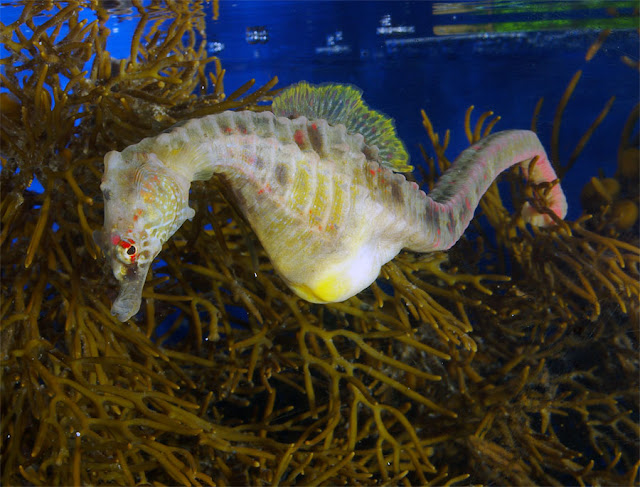The Life of Animals | Sea Horse | Sea Horse size from 0.6 to 14, look for their horses named. Each species has a distinct number of rings. Seahorses swim upright, another characteristic that is not shared by their close pipe fish relatives, which swim horizontally. Unusual among fish, seahorses have a flexible, well-defined neck. Seahorses have no tail. The fossils of seahorses is very scarce. The earliest known fossils of seahorses are two pipefish-like species, H. and H. Sarmaticus slovenicus of coprolitic horizon Tunjice Hills, a middle Miocene deposits in Slovenia is about 13 million years ago. Molecular dating is that pipefish and seahorses separated in the late Oligocene.
The male seahorse nest provided with a pocket on his stomach, or for a specific, silk. When mating, the female seahorse deposits up to 1,500 eggs in the pouch of the male. The male carries the eggs for 9 to 45 days out to go to the seahorses fully developed, but very small. Once the seahorses into the water, dismissed the male role and he has done no further care. is a common misconception about seahorses that they mate for life. Many species of seahorses form pair bonds that last through at least the breeding season. Some species show a higher degree of loyalty than other partners. However, many species easily switch mates when the opportunity arises.
Seahorses feed on small crustaceans in the water swimming or crawling on the floor. With great stealth and patience, ambush prey that seahorses floating within striking distance range. Mysid shrimp and other small crustaceans are favorites, but some eat seahorses observed other species of invertebrates and even fish larvae.
Many species of seahorses are inadequate data, and there is not enough information about their risk of extinction, to judge. Since the seahorse populations is unknown, there is a risk of losing more sea horses, because of the lack of information about how many die each year, how many are born, the number of souvenirs etc. deteriorating coral reefs and seagrass beds, reducing viable habitat for seahorses. While many hobbyists keep seahorses as pets, seahorses tend by nature a poor home in aquariums.
Although more expensive captive bred seahorses, they take no toll on wild populations. Seahorses are slow eaters will be as fast, aggressive investors, they leave without food. Seahorses can co-exist with many species of shrimp and other bottom-feeding creatures. Goby, a good tank-mates. Keepers will usually avoid eels, surgeon fish, trigger fish, squid, octopus, sea anemones and advice. To animals as "freshwater seahorses" sold, are usually the closely related pipefish, of which some species live in the lower reaches of rivers. The supposed true "freshwater seahorse" called H. Aimei not true species, but a name was sometimes used by Barbour and Hedgehog seahorse. The latter is a species that are found in brackish water, but can not truly a freshwater fish.
Seahorse population is believed to have been in recent years threatened by overfishing and habitat destruction. The seahorse is used in traditional Chinese herbalism, and shall not be less than 20 million seahorses may be caught and sold for this purpose. Medicinal seahorses are not easily bred in captivity, because they are susceptible to disease and you take on different medicinal properties of seahorse tank must have. Seahorses are also used as medicines by the Indonesians, the Filipinos used Central and many other ethnic groups. Import and export of seahorses is under CITES since the 15th May 2004 regulated.
Declining availability of the large, pale and smooth seahorses has been the shift towards prepackaged medicines it possible for TCM merchants to sell previously unused juvenile, spiny and dark-colored animals, make resolves. Today, nearly a third of the seahorses sold in China are prepackaged, in addition to the pressure of the species. Pygmy seahorses are less than 15 millimeters (0.59 inches) long and 17 millimeters (0.67 inches) wide members of the genus. Molecular analysis (ribosomal RNA) from 32 species revealed that H. hippocampus bargibanti belongs in a clade separate from other members of the genus, so that the species differs from other species in the "old" past. Most are well camouflaged and pygmy seahorses live in close collaboration with other organisms, including colonial hydrozoans (Lytocarpus and Antennellopsis), calcareous algae (Halimeda), gorgonians (Muricella, Annella, Acanthogorgia).
Find The Life of Animals





